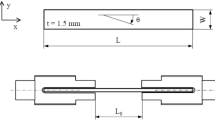Abstract
Strength results for a filled epoxy are reported for biaxial stresses. Three test methods and several specimen configurations were employed. Strength magnitudes were quite dependent upon specimen geometry under compression-compression stresses. For other stress states, this dependence disappeared and the modified Coulomb-Mohr theory fit the data well. Similar data for graphite are cited.
Similar content being viewed by others
References
Coronet, I. andGrassi, R. C., “A Study of Theories of Fracture Under Combined Stresses,”Inl. of Basic Engineering,83,33–44 (March1961).
Ely, R. E., “Strength of Titania and Aluminum Silicate Under Combined Stresses,”J. Amer. Ceramic Soc.,55(7),347–350 (July1972).
Sine, G., An Experimental Study on the Compressive Biaxial Strength of Ceramics, Univ. of Calif., Report UCLA-ENG-7172, (Oct. 1971).
Ely, R. E., “Biaxial Stress Testing of Acrylic Tube Specimens,”Polymer Engineering and Science,7(1),40–44 (Jan,1967).
Ely, R. E., “Strength of Magnesium Silicate and Graphite Under Biaxial Stresses,”Amer. Ceramic Soc. Bull.,47(5),489–492 (7 May1968).
Weng, T., “Biaxial Fracture Strength and Mechanical Properties of Graphite-Base Refractory Composites,”AIAA Jnl.,7(5),851–858 (May1969).
Broutman, L. J., Krishnakumar, S. M., andMallick, P. K., “Effects of Combined Stresses on Fracture of Alumina and Graphite,”Jnl. Amer. Ceramic Soc.,53 (12),649–654 (Dec.1970).
Ely, R. E., “Strength Results for Two Brittle Materials Under Biaxial Stresses,”U. S. Army Missile Command, Redstone Arsenal, Alabama, Report No. RR-72-11 (Sept. 1972).
Romano, M., “On Leon's Criterion,”Meccanica (AIMETA),4(1),48–66 (March1969).
Paul, B., “A Modification of the Coulomb-Mohr Theory of Fracture,”J. of Appl. Mech.,28,Trans. ASME,83,259–268 (June1961).
Fisher, J. C., “A Criterion for the Failure of Cast Iron,”ASTM Bull., (181),74–75 (April1952).
Coffin, L. F., “The Flow and Fracture of a Brittle Material,”Jnl. of Appl. Mech.,17,Trans. ASME,72,233–248 (1950).
Perkins, R. D., et al., Multiaxial Loading Behavior of Four Materials Including ATJS Graphite and RAD-6300 Carbon Phenolic, General Motors Corp., Materials and Structures Laboratory, Technical Report SAMSO-TR-69-393, 1,Contract F04701-68-C-0161 (Aug. 1970).
Broutman, L. J., andCornish, R. H., “Effect of Polyaxial Stress States on Failure Strength of Alumina Ceramics,”Jnl. Amer. Ceramic Soc.,48 (10),519–524 (Oct.1965).
Author information
Authors and Affiliations
Rights and permissions
About this article
Cite this article
Ely, R.E. Biaxial fracture stresses for filled-epoxy tubes. Experimental Mechanics 14, 492–496 (1974). https://doi.org/10.1007/BF02323150
Issue Date:
DOI: https://doi.org/10.1007/BF02323150




